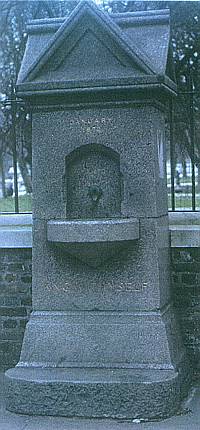|
One of the first requirements for any permanent settlement is potable water from a reliable source. Indeed, without that no settlement can be contemplated. Gardening and ornamentation is not an occupation seriously undertaken in times of war or famine or civil distress. It follows, therefore, that the success of a civilization can be measured by its gardens and water features, which were developed directly as a consequence of the well being of that civilization. In earliest settlements, as now, the fountain took pride of civic place for both citizens and visitors to illustrate the power and civilization of a community. The control of water resources was the first necessity of the well ordered state and the deprivation of those resources one of its most powerful sanctions. In Rome banishment meant depravation of the fire and water of Rome. The Fountains in early civilization had four principle functions. The supply of drinking water. Fresh spring water is very often better in quality and taste than water stored in reservoirs, tanks and ponds. Although recent research into the characteristics of water indicate that stored water can be rejuvenated, throughout history, where a spring or fountainhead is available to the public, they make use of it. This inevitably made fountains a unofficial meeting point, as the water cooler still is today in the United States and other civilized countries. In Syracuse in Sicily the citizens still take jugs to the springs to collect fresh drinking water. In certain aspects it is only in the 19th century that we have exceeded the ancient Romans in our supply of domestic water supply. In London and the United Kingdom, drinking water which was controlled by private companies at the end of the 18th century. At that time at least three water companies derived their supply from the Thames. The oldest raised it by water wheels at London Bridge; a second pumped water out near the Strand, a third brought it from the river at Chelsea. It was expensive, often polluted and badly and unreliably supplied at that time. Sewerage arrangements were inadequate and often foul water was fed into the water supply.
In Paris in the early 19th century the situation was similarly dire . When Haussman arrived inthe capital in 1833 the water supply system had not been improved since the turn of the century. In Paris there were close to 2000 public fountains and the water from the Seine was raised by pump at Chaillot and Austerlitz. . Water porters carried the water to homes but the water was very polluted and water filters were on sale. In his design for Paris Haussman was committed to the provision of abundant, pure water to the domestic dwellings. The new systems being installed in London were used as a model. Water was provided using a new system of masonry aqueducts and metal pipes. At considerable expense, an adequate sewage system was built with excellent sewers leading to land purchased by the city for safe disposal. These works were mainly undertaken between 1860 and 1865. Since then advances in domestic supply to most modern homes have drastically reduced the need for public drinking fountains in cities. The supply of water for animals. Fountains provided an informal meeting point by necessity for drovers and herders marketing their animals. These are best illustrated by the water troughs which were widespread in this country in the late nineteenth and early twentieth century. Many of these have now been removed or are used as planters. They were frequently gifts of prominent citizens. Examples can be seen in London streets as well as small villages such as Pycombe and Cuckfield in Sussex. The supply of domestic water for washing, cleaning and cooking. This led to an informal meeting point where women in particular met on a frequent basis as it is often impractical to carry the quantity of water required for washing from a fountainhead. Indeed many women in warmer climes very much miss the social gatherings about the washing facilities that they had until recently enjoyed for centuries. The old washing tables can still be seen in the south of France and Majorca. In this country the arrangements were not so sophisticated and consideration was not always given to other users of the fountain. In the Petworth Archives in the 17th century Lord Leconfield noted fines for washing bullocks entrails at the common tap. Display and communication centre. Mankind loves to embellish and with the fountain he has had ample scope. In Europe particularly, local authorities have seen fit to improve the fountain as the natural focal points of the town and community and private owners, leaders and kings have seen fit to undertake a wide range of improvements. Fountains demand from the public offerings; currently the Trevi fountain in Rome has coins thrown in it to the value of over 100, 000 Italian lira per week . So a display fountain owner should always check his fountain for valued gifts before declaring him or her self bankrupt. Most recently the introduction of submersable electic pumps and micro technology have made possible a new form of mobile display which compete with fireworks in public appeal. |

http://www.gardening-uk.com/waterlands/
email: b.hirst@mac.com
